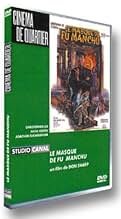The Face of Fu Manchu
- 1965
- 1h 29m
IMDb RATING
5.8/10
2.1K
YOUR RATING
After cheating death, master criminal Dr. Fu Manchu returns with a plot to contaminate the River Thames with a powerful toxin extracted from Tibetan poppies.After cheating death, master criminal Dr. Fu Manchu returns with a plot to contaminate the River Thames with a powerful toxin extracted from Tibetan poppies.After cheating death, master criminal Dr. Fu Manchu returns with a plot to contaminate the River Thames with a powerful toxin extracted from Tibetan poppies.
Howard Marion-Crawford
- Dr. Petrie
- (as Howard Marion Crawford)
Francesca Tu
- Lotus
- (as Poulet Tu)
Peter Mosbacher
- Hanumon
- (as Peter Mossbacher)
Ric Young
- Grand Lama
- (as Eric Young)
Deborah DeLacey
- Slave Girl
- (as Deborah De Lacey)
- Director
- Writers
- All cast & crew
- Production, box office & more at IMDbPro
Storyline
Did you know
- TriviaChristopher Lee wrote in his memoirs, how his leading lady Tsai Chin assisted him with memorizing the Cantonese dialogue.
- GoofsAs the two soldiers stop for a cup of tea, one leans his rifle against the table behind them. It then slowly falls over, totally ignored by the two men as they discuss the weather.
- Alternate versionsWhen originally released theatrically in the UK, the BBFC made cuts to secure a 'U' rating. All cuts were waived in 1991 when the film was granted a 'PG' certificate for home video.
- ConnectionsFeatured in London Labyrinth (1993)
Featured review
Hit and run independent film financier Harry Alan Towers made his bid for the big time in 1965. Spending more money than he ever had (or would) again, scouting attractive international locations, hiring respected craftsmen and actors and launching a multi-million dollar publicity campaign to promote his pet project. "The Face of Fu Manchu", the unlikely recipient of all this attention, represents a plateau to which Towers would never aspire again.
After publicly purchasing the pulp adventure novels of Sax Rohmer, Towers signed horror film icon Christopher Lee to a six-picture deal as the title menace. As director, Towers hired Don Sharp, maker of numerous elegant, effective horror films and probably the most talented director to put his name on a Towers contract. Writing the script himself under his nom de cinema Peter Welbeck, Towers ignored the plots of all the Rohmer novels and concocted his own. The film wisely retains the period setting of early-twentieth century London (which required shooting in Dublin, for the sake of authenticity), but alters the deductive tone of the books in favor of action sequences in the style of the James Bond films, which were then in their first flush of international success.
The finished film is beautiful to see, filmed in technicolor and cinemascope, it truly looks more expensive than it is. Encouraged, Towers launched an expensive international publicity campaign whose most notable stunt was wallpapering election-year New York City with oversized "Fu Manchu For Mayor" posters
In the end, "Face" failed to return enough money to justify the huge outlay spent in making and promoting it. The film seemed to please no one: fans of the series were outraged by the James Bondian gunplay, fights and car chases, while Bond fans were alienated by the period trappings (1920s cars just don't go that fast!). More likely, this type of film just did not have the potential to reach the mainstream audience needed to make it a success.
Although Towers continued the series, the films would steadily decline in quality, from the high point of "Face" to the home-movie calibre of the final entry, "Castle of Fu Manchu".
After publicly purchasing the pulp adventure novels of Sax Rohmer, Towers signed horror film icon Christopher Lee to a six-picture deal as the title menace. As director, Towers hired Don Sharp, maker of numerous elegant, effective horror films and probably the most talented director to put his name on a Towers contract. Writing the script himself under his nom de cinema Peter Welbeck, Towers ignored the plots of all the Rohmer novels and concocted his own. The film wisely retains the period setting of early-twentieth century London (which required shooting in Dublin, for the sake of authenticity), but alters the deductive tone of the books in favor of action sequences in the style of the James Bond films, which were then in their first flush of international success.
The finished film is beautiful to see, filmed in technicolor and cinemascope, it truly looks more expensive than it is. Encouraged, Towers launched an expensive international publicity campaign whose most notable stunt was wallpapering election-year New York City with oversized "Fu Manchu For Mayor" posters
In the end, "Face" failed to return enough money to justify the huge outlay spent in making and promoting it. The film seemed to please no one: fans of the series were outraged by the James Bondian gunplay, fights and car chases, while Bond fans were alienated by the period trappings (1920s cars just don't go that fast!). More likely, this type of film just did not have the potential to reach the mainstream audience needed to make it a success.
Although Towers continued the series, the films would steadily decline in quality, from the high point of "Face" to the home-movie calibre of the final entry, "Castle of Fu Manchu".
- How long is The Face of Fu Manchu?Powered by Alexa
Details
Box office
- Gross US & Canada
- $2,834,000
- Runtime1 hour 29 minutes
- Aspect ratio
- 2.35 : 1
Contribute to this page
Suggest an edit or add missing content



































